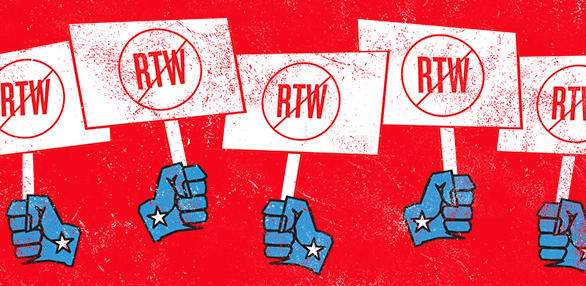“Right-to-work” laws are nothing new. The first states to adopt such laws did so in the 1940s and 50s. But between 1960 and 2012, a span of 52 years, only four states became “right to work.”
In contrast, since 2012, six states have adopted so-called “right-to-work” laws – Indiana, Michigan, Wisconsin, West Virginia, and, just this year, Kentucky and Missouri.
What’s going on?
“Right to work” schemes make it harder for workers to form strong labor unions through which they can organize and speak with one voice on the job. At a time of extreme inequality in our country, legislators should be making it easier, not harder, for workers to unite. The question of why this is happening now has to do with money in our politics, the power of special interests and the influence of right-wing extremists.
But the recent conversions in the Midwest set the stage for a kind of regional experiment that is helping us answer another important question: What’s the impact of “right-to-work” laws on a state’s workforce?
By tracking certain economic indicators in three newly-minted “right-to-work” states and comparing them with three collective bargaining states, researchers Frank Manzo IV of the Illinois Economic Policy Institute and Robert Bruno of the University of Illinois, Urbana-Champaign, set out to answer this question. They compared Indiana, Michigan and Wisconsin, on the one hand, with Illinois, Minnesota and Ohio.
What they found leaves little doubt that “right-to-work” schemes harm workers. In a study published this month, which studies the period from 2010 to 2016, Manzo and Bruno write, “Based on data over recent years, RTW has had particularly negative consequences for many middle-class workers in Indiana, Michigan, and Wisconsin. These include working-class Americans in construction, protective services, office support jobs, and those with two- and four-year college degrees.”
In particular, they point out that “right-to-work” schemes have statistically lowered the hourly wages of:
- Construction and extraction workers by 5.9 percent;
- Workers in service occupations, including police officers and fire fighters, by 3.1 percent;
- Workers in office and administrative support roles by 2.7 percent;
- Employees in retail and business sales by 2.4 percent;
- Professional, educational, and health workers by 1.9 percent.
Manzo and Bruno also found that “right-to-work” schemes reduced the unionization rate by 2.1 percent on average.
Nobody wins with “right to work.” Or, nobody wins except the rich. “Right-to-work” schemes are designed to benefit the wealthy at the expense of average Americans on the job.
